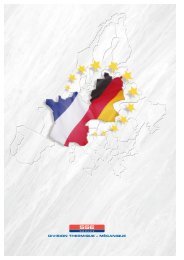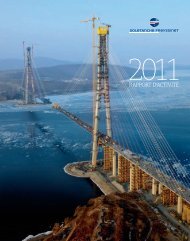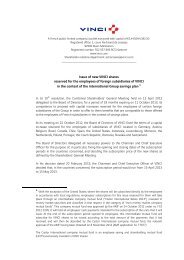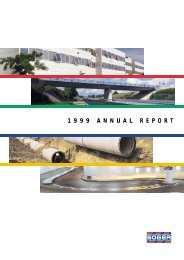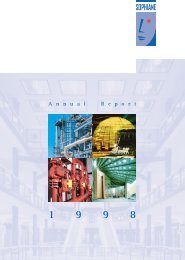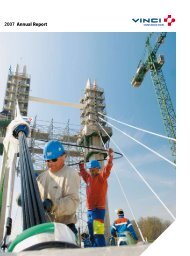VINCI - 2005 annual report
VINCI - 2005 annual report
VINCI - 2005 annual report
You also want an ePaper? Increase the reach of your titles
YUMPU automatically turns print PDFs into web optimized ePapers that Google loves.
2. THE OBJECTIVES OF INTERNAL CONTROL<br />
2.1. DEFINITION<br />
Pending publication of the recommendation being prepared under the<br />
aegis of the AMF, <strong>VINCI</strong> again in <strong>2005</strong> adopted the defi nition of the<br />
Committee of Sponsoring Organisations (COSO), which is the most<br />
commonly accepted defi nition internationally:<br />
“Internal control is a process, effected by an entity’s Board of Directors, management and other<br />
personnel, designed to provide reasonable assurance regarding the achievement of objectives in<br />
2.2. LIMITS OF INTERNAL CONTROL<br />
One of the objectives of internal control is the prevention and control<br />
of risks arising from an enterprise’s activities and the risks of error and<br />
fraud, in particular in the areas of accounting and fi nance.<br />
170<br />
<strong>VINCI</strong> <strong>2005</strong> ANNUAL REPORT<br />
the following categories:<br />
– effectiveness and effi ciency of operations;<br />
– reliability of fi nancial <strong>report</strong>ing;<br />
– compliance with applicable laws and regulations.”<br />
However, like any control system, internal control, however well designed<br />
and implemented, cannot provide an absolute guarantee that these risks<br />
have been completely eliminated.<br />
3. GENERAL ORGANISATION AND THE ENVIRONMENT<br />
OF INTERNAL CONTROL<br />
3.1. THE BOARD OF DIRECTORS AND THE AUDIT COMMITTEE<br />
The <strong>VINCI</strong> Board of Directors represents all the shareholders collectively<br />
and commits itself to act in all circumstances in the enterprise’s<br />
corporate interest. It considers all major matters arising in the Group’s<br />
business, in particular its major strategic choices.<br />
3.2. THE EXECUTIVE COMMITTEE<br />
The Executive Committee is in charge of executing the Group’s strategy and<br />
of defi ning and implementing its management policies relating to fi nances,<br />
human resources, safety, insurance, etc.<br />
In <strong>2005</strong>, the Executive Committee had seven members: the Chairman and<br />
CEO, who was also the Chairman of <strong>VINCI</strong> Concessions, the Director and<br />
Co-Chief Operating Offi cer who became Vice-Chairman of the Board of<br />
Directors at the beginning of <strong>2005</strong>, the two Co-Chief Operating Offi cers<br />
(who are also the Chairmen of the Energy and Roads business lines), the<br />
3.3. GUIDELINES<br />
The Chairmen of the companies heading business lines (<strong>VINCI</strong> Energies,<br />
Eurovia and <strong>VINCI</strong> Construction) and the Chief Executive Offi cer<br />
of <strong>VINCI</strong> Concessions exercise the powers given to them by law. Under<br />
the Group’s internal organisation, they are also required to comply<br />
with the guidelines issued by <strong>VINCI</strong>’s Chief Executive Offi cer. These<br />
guidelines apply to the following areas:<br />
– acceptance of new business, replies to tenders, offers of services and<br />
for projects, studies, provision of services, concessions (including<br />
public private-partnerships) and project organisation;<br />
– real-estate investments;<br />
– fi nancial investments and divestments;<br />
The Board of Directors has delegated certain specifi c tasks to the Audit<br />
Committee regarding internal control and risk management, such as for<br />
example the monitoring of provisions and off-balance sheet commitments.<br />
Chairman of the Construction business line, the Group’s Vice-President, Chief<br />
Financial Offi cer and its Vice-President, Corporate Communication, Human<br />
Resources and Synergies.<br />
As from 9 January 2006, the members of the Executive Committee are: the<br />
Group’s Chief Executive Offi cer, the Chairmen of the Construction, Energies<br />
and Roads divisions, the Chief Executive Offi cer of <strong>VINCI</strong> Concessions, the<br />
Executive Vice-President, Chief Financial Offi cer and its Executive Vice-President,<br />
Corporate Communications, Human Resources and Synergies.<br />
– employment matters;<br />
– fi nancial and banking relations, tax, insurance;<br />
– guarantees, collateral and security;<br />
– external and internal communication;<br />
– major risks.<br />
In particular, these guidelines require compliance with the holding<br />
company’s procedures regarding the acceptance of new business or<br />
the making of investments. These procedures defi ne the thresholds<br />
above which specifi c authorisation has to be obtained or prior information<br />
submitted to the Chairman and Chief Executive Offi cer or<br />
certain <strong>VINCI</strong> functional departments or both.




